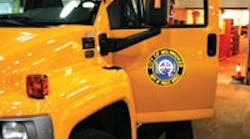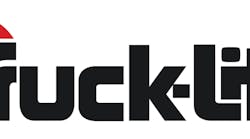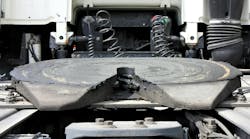Counterfeiting: it sounds like something reminiscent of a spy movie, where some evil henchman would be hunched and sweating over a machine producing bill after bill—piles of green paper with no commercial worth. Yet in the truck parts industry the problem is anything but fiction, and the currency is a variety of vehicle accessories, most notably lighting products.
The estimate of the numbers of counterfeit products flooding the market varies, but one thing is for certain—the manufacturers who are concerned with valid products that fit legal safety standards are taking a major financial hit as these inferior products swallow their business.
TSEI
The Transportation Safety Equipment Institute (TSEI) is a non-profit trade association that promotes the development of advanced performance standards and federal and state government and international regulations for the commercial vehicular safety equipment industry. TSEI's efforts focus on promoting the integrity of its members and the industry through product certification, testing, government enforcement and compliance activities.
TSEI is involved with safety-related issues on behalf of both the OEM and aftermarket, with the foundation of the organization focuses on highway safety. In addition to conducting research and testing, TSEI also serves as a technical forum for those in the industry to address safety concerns.
TSEI is a Motor and Equipment Manufacturers Association (MEMA) managed trade association.
COMPLIANCY VS. COUNTERFEITING
TSEI is involved in the process of finding both counterfeit products and non-compliant parts and accessories, although the two are not necessarily interchangeable. Brian Duggan, director of trade and commercial policy for MEMA, explains the difference between the two categories.
"There are two separate issues you've got. Non-compliance is a violation of the National Highway Traffic Safety Administration (NHTSA). In other words, if you take the light and you test it and it doesn't meet the NHTSA standard and it's supposed to be installed on a car or a truck, then it's not compliant. It's not a criminal matter, but you did violate the federal safety standards and you have to get those lights off the market," Duggan explains.
"The counterfeiting issue is a criminal and civil matter," he says. "If they violate your trademark, a company can issue a cease and desist order. Trademark violation is also a criminal matter—in other words, it's not just a matter of me or a company suing the infringer—they can actually bring it to the attention of the federal and state authorities."
TAKING A FAKE TO TASK
"If they find a light in the market that they think is non-compliant, a lot of times the members of this group will bring it back and do round-robin testing in their own labs," Duggan explains. "They're just companies—they can't enforce the law, but they can bring it to the attention of regulators and say 'we've tested it, perhaps you should, too, because it failed.' And then the government has to take it from there. There's a number of ways that they can do that. They can actually test the light, they can contact the manufacturer, or—let's say it was manufactured outside of the United States—they can contact the fellows who import it and sell it and say, 'Can you prove to us that this light complies?'"
BUDGET WOES
Companies who focus specifically on the lighting market, such as Truck-Lite, have seen the most dramatic effects from the emergence of counterfeit lighting. Brad Van Riper, vice president of research and development for Truck-Lite, explains how the effects are rippling and, often, indeterminable.
"The emergence of counterfeit and non-compliant lighting products has affected our product sales, as we have been displaced completely in some markets—like the local truck stop suppliers—where we used to be a dominant player," Van Riper says.
Perhaps the most frustrating element to this complex issue is the fact that it can be so difficult to quantify the lost sales of a valid lighting company. MEMA's vice president of communication, Neal Zipser, elaborates on this: "Obviously you have lost sales, which is first. Second, you've got any type of litigation costs, as well as dilution of the brand name. If it's a counterfeit product, it's a good possibility they're finding out about it through their warranty return channel, so they'll see higher warranty and return costs," he says. "They might have to change their packaging to try to stay ahead of the counterfeiters, so that's another cost there.
Truck-Lite's perspective is similar when dealing with the exasperating scenario of potential lost business: "It is really difficult to guess how much we have really lost," Van Riper says. "Even worse are the losses for our customers, which tend to manifest themselves in performance and safety issues."
FLEETS: HOW TO SPOT A THIEF
Lost business for a manufacturer most likely means eventual trickle down costs for fleets. A fleet manager can address the issue of counterfeit and non-compiant parts by refusing to purchase them. This requires having enough knowledge to know which parts are non-compliant, how to avoid them and why.
"We are helping our customers gain awareness of the responsibilities of a lighting manufacturer," Van Riper says. He goes on to describe ways in which a buyer may get more than they bargain for when purchasing a non-compliant product from an unregistered foreign supplier, such as the "potential product liability that each of them assumes by buying products that do not have a US address."
Duggan gives a few suggestions for how fleets can protect themselves before purchase: "Customers should beware that if a deal is too good to be true, it probably is. There's a reason why it is so cheap," he says. "If it's from a supplier or a source other than a known source for this kind of regulated product, well, that might throw up a caution too. Why is this guy who doesn't normally sell lighting... why is he doing this?"
Zipser adds, "One of the problems, obviously, is on the packaging you find on the aftermarket products," he says. "A lot of the non-compliant companies will put down that they do comply with the standards when in fact they don't. There's definitely a deceiving trying to go on to the truck part buyer or the fleet manager."
SAFETY LAST?
Financial stress is an important result of this process, and obviously safety is too. Counterfeit products that are also non-compliant can result in a safety burden on fleets. One way of keeping the costs down in a counterfeit product is by cutting corners, and it is often the safety and reliability that get thrown by the wayside. In addition, a company that is using another company's brand is less likely to be motivated by registered safety organizations, or by wanting to maintain a quality reputation in the marketplace.
"A lot of times counterfeit products are cheaply made; often they are imported—not always, but often they are imported—so not only are they violations of trademark, they don't meet the federal safety standard either," Duggan says.
A fleet that is operating with a non-compliant product could spend less initially, but find later that the product causes more unforseen safety and maintenance concerns than it is worth.
Fortunately for legitimate lighting manufacturers, there are organizations like TSEI to provide help. Dominic Grote, vice president of sales and marketing for Grote Industries and current president of TSEI, describes its benefits.
"Grote has been an active member of TSEI since its founding in 1962," Grote says. "TSEI has taken proactive steps to educate the public, including end-users, distributors and OEMs, about the fact that a non-compliant product in the marketplace poses a safety risk to end-users, as well as distributors and OEMs from a liability standpoint."
Grote continues, "We, along with other TSEI members, firmly believe that there are no shortcuts to quality and compliant lighting systems."
THE TSEI SOLUTION
Luckily for fleets, TSEI is on the job, hoping to stop counterfeit and non-compliant products before they reach someone at the purchase decision point. This includes trying to get more government accountability for compliancy issues. According to Duggan, the government is willing:
"We lobby for compliance with standards," Duggan says. "But we don't need to convince the government of anything; they want to enforce their standards."
Non-compliance is not the only cause for maintenance concerns.
Vanishing Electrical Systems: Wires Disappear with Multiplexing
It's an old problem in America's prisons and schools, but overcrowding on a truck? With abundant accessories, cab fixtures and capabilities, the wiring systems that carry data throughout a medium-duty vehicle these days can often become cramped and unmanageable.
Multiplexing allows for a fewer number of internal data wires, as certain single wires can be programmed to carry different loads of information at different times. The key to multiplexing is allowing for separate data to be transmitted, making sure that only the message that needs to be sent is the one occupying the line. The folks at International Truck know a lot about multiplexing because they have developed their own proprietary system.
Hardware manager for International, Brian Marts, explains the reason behind the transition to multiplexing. "What's really going on is you've got more and more electronic controllers on a vehicle. One thing that was happening was you would have gigantic bundle sizes of potentially hundreds of wires," Marts says. "That all became very difficult to string and package around the space requirements on a truck.
"What you have with multiplexing," he continues, "is all of your modules communicating on the same protocol."
HOW, WHEN, AND WIRE?
Sound like a lot of engineering jargon? Here's where the benefits come in for maintenance: "What's nice about (multiplexing) is you only need one tool to access each of those modules," Marts says. "It used to be—in the old times—you would have to have more than one service tool… very much like a skyscraper where every floor has its own unique number, same thing with each of the modules. So now you've got the power to basically query anything in the electrical system that is connected to that."
Another advantage in terms of maintenance is the way in which multiplexed systems often have the ability to self-diagnose problems. This goes back to the on-board diagnostic system in a vehicle: if a command goes out and gets no response, it can send back a maintenance alert to the database.
KEEPING UP
"Because we put more electrical content in, there is a potential downside for people because it can be kind of hard to understand how the pieces work," Marts says. "So as things get more sophisticated, you need training to understand the new material. We offer the International Service Information System (ISIS)."
In the form of a CD-ROM, ISIS includes service manuals and circuit diagrams, as well as background technical information on almost all International models. According to their website, the ambitions of ISIS are for it to be "a single volume in what will become an encyclopedia of service data delivered electronically to every service bay in the International network."
MANUFACTURERS DO THEIR PART
New systems mean a change in operations from a manufacturer perspective. For Grote Industries, multiplexing created a whole new venue of additional testing procedures for their lighting products. Walt Bronson, product manager, turn signal switches for Grote Industries explains the preventative testing regimen:
"All product designs are subjected to a minimum of three levels of validation testing and analysis before production shipments begin," Bronson says. "On-vehicle road testing will also be completed at each validation series to ensure actual performance and drive-ability of the product."
Truck-Lite also believes that the easiest way to track and deal with failures is by preventing them altogether. "With the development of LED light sources, it is far more cost effective to develop lighting products that can likely last the life of the vehicle, rather than work on proactively determining when the failure will occur," Van Riper says. "Truck-Lite has registered the phrase ‘Fit and Forget' as an example of how long these new extremely robust products will last."
Still, no matter how informed a supplier is in the manufacturing process, it is still a good idea for techs to be prepared for the worst. Most of the failures in lighting products, according to Grote's chart on the subject, seem to come from improper installation, storage or external concerns (like weather). Tracking and replacing these failures will keep trucks out of the shops and on the roads.
Truck Wiring and Lighting: 9 Common Causes of Failure
(Courtesy of Grote Industries)
**Moisture & Corrosion: Condensed water droplets inside a lens or corrosion around a lamp socket are sure signs that moisture has penetrated the system. Water can enter the system through ineffective wire seals, unprotected splices, unsealed crimps and connectors and non-mating seals. When making repairs, don't replace a sealed system with unsealed components. Make certain that connector seals are in place and undamaged. Inspect them carefully for cuts, tears and punctures.
**Chemical Damage: Continuous exposure to many of the common chemicals found in and around trucks can cause plastics to swell, crack, soften or otherwise become degraded. Diesel fuel and hot engine oil are the main culprits. To minimize the effects of chemicals, inspect the wiring for signs of degradation. If it is occurring in an area that is generally free from contamination, check for leaky hoses, gaskets or fittings, and repair if damaged or leaking. To avoid damage from chemicals, don't run wiring in areas where the chance for continuous exposure is likely, such as under fuel lines and filters.
**Abrasion: Abrasion occurs when wires or wire wraps are allowed to rub against frame members or other abrasive surfaces. Once the insulation is worn away, bare conductors may contact a ground surface and create a grounded circuit. Or, it could cause wear to the point of fracture, resulting in an open circuit. Using the proper routing and coverings will help to prevent wear areas and abrasive damage. Worn coverings such as loom, convoluted tubing or spiral wrap should be replaced if they are no longer providing sufficient protection for the wires inside.
**Impact: Lighting and wiring must be protected from the impact of rocks, gravel, and other road debris. A major impact can cause enough damage to require extensive repairs. Smaller, more frequent impacts over time may deliver equally extensive damage. Damage from impacts can do damage although the wires are contained in a loom or other covering. During inspection, always check for damage from impacts and replace and wiring or lights that appear to be damaged. Make certain that the replacement parts are equivalent to or better than the original.
**Vibration: Broken lamp filaments are one of the most common problems caused by vibration, but it can also lead to the abrasion of mating surfaces which causes connectors and splices to fail. To minimize vibration problems, make certain that all wires and connectors are secured appropriately. Always secure the wiring as it exits the connector. Use cushioned mountings for lamps in applications where vibration failure is excessive.
**Grit & Sand: Accumulation of abrasive materials can lead to damage, especially when combined with vibration. If gritty materials enter connections, it can accelerate the wear contact points causing interruption of the circuit and failure of the devices. Sand and grit can also attract and hold moisture, creating conditions conducive to corrosion. In some cases, sand and grit may work their way inside protective coverings and abrade the insulation of wires running through it if there is relative motion between the covering and the wire. One of the ways of reducing sand and grit buildup is to eliminate abrasive materials in the areas where wiring is present. Another way is to seal openings on protective coverings to keep gritty materials from entering.
**Extreme Temp: There are a variety of conditions that lead to extreme temperature buildup which can damage lighting and wiring. These include leaving a trailer's tail lights on when the trailer is backed up to a dock and air flow around the light is prohibited. When lights have been damaged from heat buildup, the lenses are often bubbled and misshapen. Where extreme temperatures can't be avoided, special heat-resistant wires and materials should be used.
**Tensile Loads: Wiring should not be considered an appropriate load-bearing component. It's easy to exceed the designed load limit by inadvertently installing wires under tension or snagging a section of wire on one of the moving parts. Using a wire bundle as a handhold or step can destroy the integrity of the conductor and connections. So can the weight of accumulated ice, snow, mud and other materials. Each of these points must be carefully considered when routing wires in a wiring harness.
**Flexing: There are many circumstances on a truck where the wiring must not only make sharp turns around corners, but is also subjected to constant flexing where doors or hoods are opened and closed repeatedly. To prevent damage where wires must be subject to repeated flexing, avoid tight radius turns. Make sure the wire is not snagged or stressed at its maximum extension. Also, make certain that the wire moves smoothly through its flexing cycle and doesn't rub or scrape adjacent components.




